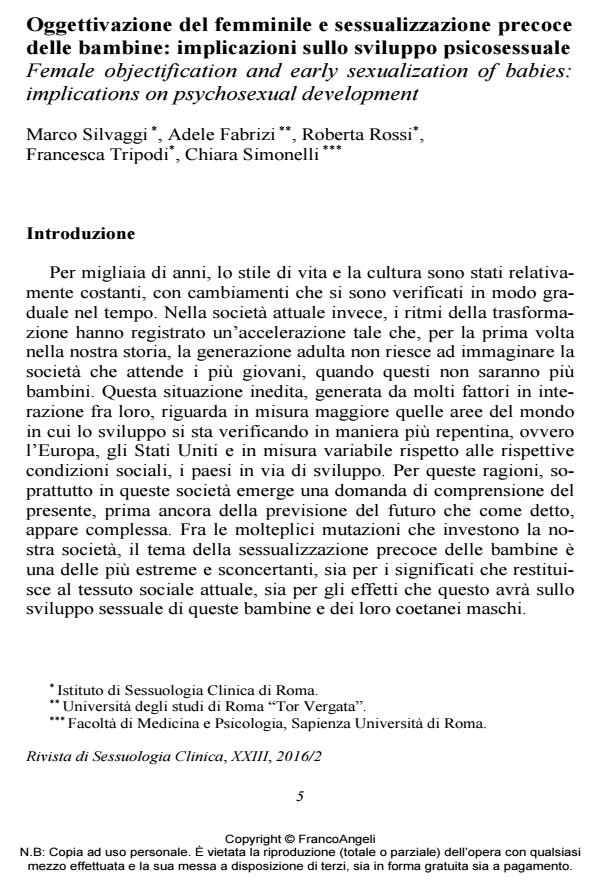Oggettivazione del femminile e sessualizzazione precoce delle bambine: implicazioni sullo sviluppo psicosessuale
Titolo Rivista RIVISTA DI SESSUOLOGIA CLINICA
Autori/Curatori Marco Silvaggi, Adele Fabrizi, Roberta Rossi, Francesca Tripodi, Chiara Simonelli
Anno di pubblicazione 2016 Fascicolo 2016/2
Lingua Italiano Numero pagine 15 P. 5-19 Dimensione file 386 KB
DOI 10.3280/RSC2016-002001
Il DOI è il codice a barre della proprietà intellettuale: per saperne di più
clicca qui
Qui sotto puoi vedere in anteprima la prima pagina di questo articolo.
Se questo articolo ti interessa, lo puoi acquistare (e scaricare in formato pdf) seguendo le facili indicazioni per acquistare il download credit. Acquista Download Credits per scaricare questo Articolo in formato PDF

FrancoAngeli è membro della Publishers International Linking Association, Inc (PILA)associazione indipendente e non profit per facilitare (attraverso i servizi tecnologici implementati da CrossRef.org) l’accesso degli studiosi ai contenuti digitali nelle pubblicazioni professionali e scientifiche
Nella società attuale, i ritmi della trasformazione hanno registrato un’accelerazione tale che, per la prima volta nella nostra storia, la generazione adulta non riesce ad immaginare la società che attende i propri figli. Per queste ragioni, emerge una domanda di comprensione del presente, prima ancora della previsione del futuro. Per il supporto della salute sessuale femminile, gli sforzi attuali sono contrapposti ad una certa pressione ad uniformarsi all’oggetto dei desideri maschili. Il continuo richiamo esercitato da uno sguardo, esterno o interno, sull’aspetto fisico interrompe la concentrazione e diminuisce la possibilità di entrare in contatto con le proprie sensazioni ed i propri bisogni. L’auspicio è quello che sempre più si diffonda la cultura del gruppo di studio e di intervento, formato da figure professionali diverse ed integrate, che possano cogliere gli aspetti fisiologici, psicologici, relazionali e culturali, sia nelle loro peculiarità, sia nello loro interazioni reciproche.
Parole chiave:Oggettificazione, sessualizzazione precoce, salute sessuale, sviluppo psicosessuale, identità sessuale
Marco Silvaggi, Adele Fabrizi, Roberta Rossi, Francesca Tripodi, Chiara Simonelli, Oggettivazione del femminile e sessualizzazione precoce delle bambine: implicazioni sullo sviluppo psicosessuale in "RIVISTA DI SESSUOLOGIA CLINICA" 2/2016, pp 5-19, DOI: 10.3280/RSC2016-002001